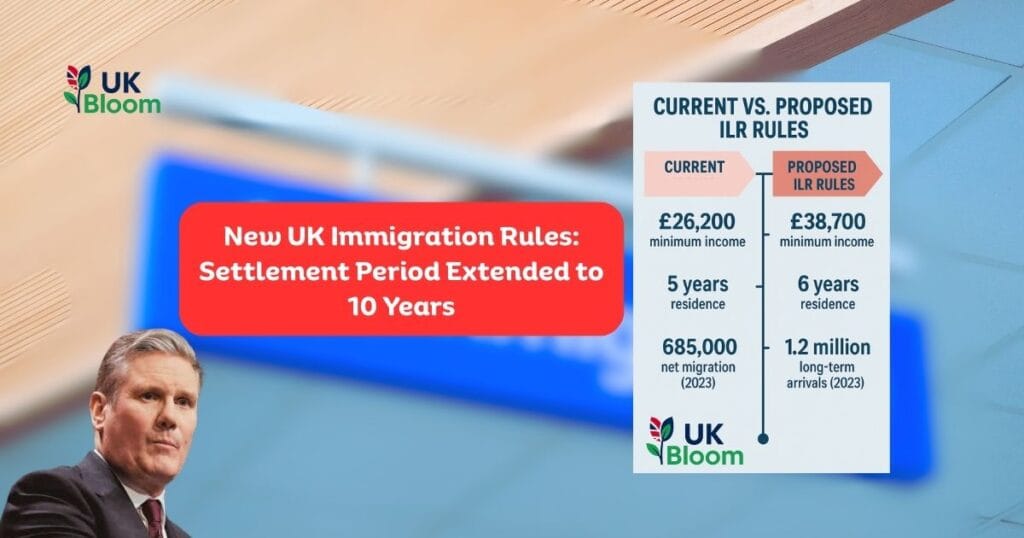Welcome to UKBloom, your go-to platform for insightful updates on UK policies. Today, we explore a pivotal change in UK immigration: the proposed extension of the residency period required for permanent settlement from five to ten years. This reform has sparked widespread debate, and we break down what it entails for migrants, employers, and families.
Table of Contents
New UK Immigration Rules in the white paper
The UK government has announced plans to overhaul the New UK Immigration Rules, with the most notable change being the extension of the Indefinite Leave to Remain (ILR) qualification period. Here’s a snapshot of the reforms:
- Extended Residency Requirement
- Most work and study visa holders will need to reside in the UK for 10 years (up from 5) to qualify for ILR.
- Exceptions apply to spouses/children of British citizens and vulnerable groups (e.g., domestic abuse survivors).
- Stricter Eligibility Criteria
- Salary thresholds for Skilled Worker visas will rise, and roles must now require a bachelor’s degree or higher (RQF Level 6).
- Post-study work visas for graduates will be shortened to 18 months, reducing opportunities to secure sponsored employment.
- Contribution-Based Reductions
- Migrants demonstrating “exceptional contributions” to the UK economy, science, or culture may fast-track their ILR application.
- Impact on Citizenship
- Naturalization as a British citizen will require at least 11 years of residency, as ILR is a prerequisite.
Why Are These Reforms Being Introduced?
The government’s Restoring Control over the Immigration System White Paper cites three primary motivations:
- Reducing Net Migration
- Record-high net migration (over 900,000 in 2023) has strained public services like healthcare and housing.
- Encouraging Long-Term Integration
- Ministers argue that permanent residency should reflect “sustained commitment” to the UK, not just temporary residence.
- Boosting Domestic Workforce Development
- By prioritizing high-skilled migrants and reducing reliance on overseas labor, the reforms aim to incentivize UK talent recruitment.
Who Will Be Most Affected?
- Skilled Workers: Engineers, IT professionals, and healthcare workers face longer paths to stability, with stricter salary and skill requirements.
- International Students: Graduates must secure sponsored roles faster, with fewer opportunities to switch visas.
- Families: Adult dependents must now meet progressive English language requirements (A1 to B2 level).
- Care Workers: Recruitment of overseas care workers will cease by 2028, pressuring existing staff to meet ILR criteria before deadlines.
Criticisms and Challenges
While the government emphasizes economic benefits, critics highlight potential pitfalls:
- Prolonged Uncertainty: Migrants may remain in temporary status for a decade, limiting access to loans, jobs, and social services.
- Employer Costs: Sponsorship fees and the Immigration Skills Charge will rise, burdening SMEs.
- Integration Barriers: Stricter language rules and digital application systems could exclude vulnerable applicants.
Migrant Voice, a leading advocacy group, warns:
“This policy risks creating a two-tier society, where migrants contribute for years without the security of permanent residency.”
Steps to Navigate the Changes
- Act Quickly: Transitional rules may protect current visa holders. Employers should file Skilled Worker applications under existing policies.
- Seek Alternatives: Explore routes like the Global Talent Visa or Ancestry Visa, which offer faster pathways.
- Prepare Documentation: Maintain records of tax payments, employment history, and language certifications to streamline future applications.
Looking Ahead
Final legislation is expected in 2026 following public consultations. For now, the message is clear: the UK aims to attract “high-value” migrants while tightening broader access.
Stay updated with UKBloom.co.uk for real-time analysis and expert insights.
Disclaimers:
Add a note like “This article is for informational purposes only. Always consult the UK Home Office or an immigration lawyer for personalized advice.”
Sources:





